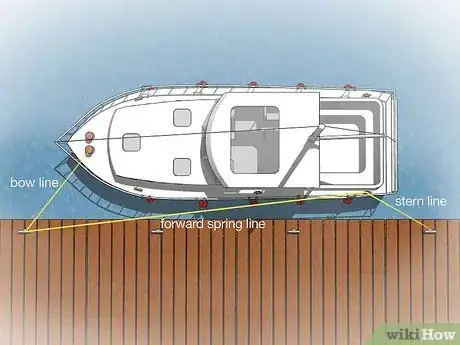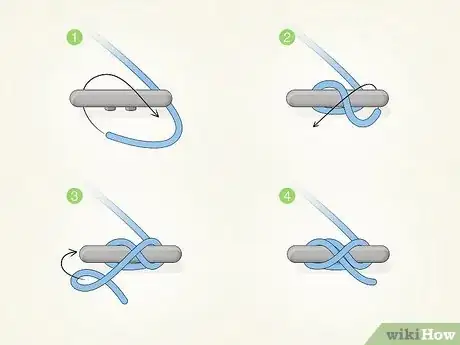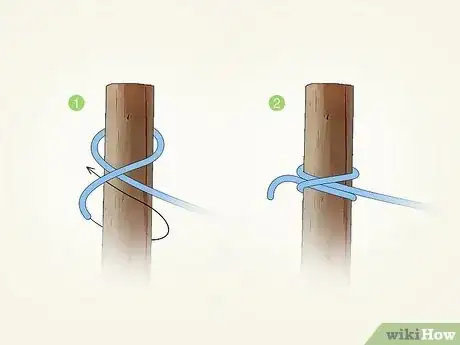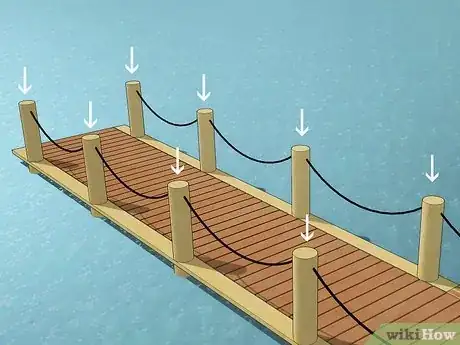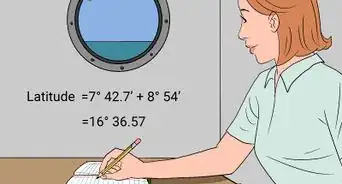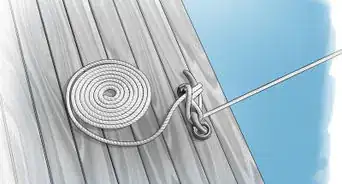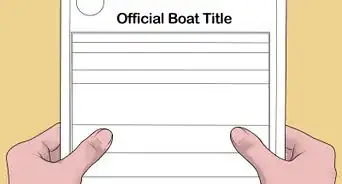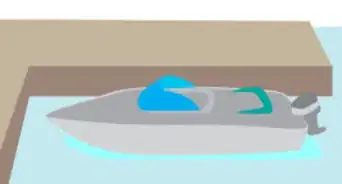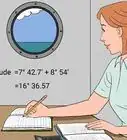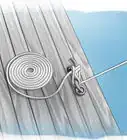This article was co-authored by Nitzan Levy. Captain Nitzan Levy is a Sailor, Social Entrepreneur, and the Founder of Sailors NYC, a recreational sailors’ club based in Jersey City, New Jersey that specializes in cruising boats and a variety of community programs. Capt. Levy has over 20 years of sailing experience and has sailed in many places around the world including: the Atlantic Ocean, the Mediterranean Sea, The Caribbean, and the Indian Ocean. Capt. Levy is a U.S. Coast Guard Licensed Master of vessels up to 50 Tons with Auxiliary Sail and Assistance Towing Endorsements. Capt. Levy is also a NauticEd Level V Captain Rank Chief Instructor, an American National Standards Assessor, an SLC instructor, an ASA (American Sailing Association) Certified Instructor Bareboat Chartering, and an Israeli licensed skipper on Boats for International Voyages.
There are 10 references cited in this article, which can be found at the bottom of the page.
wikiHow marks an article as reader-approved once it receives enough positive feedback. In this case, several readers have written to tell us that this article was helpful to them, earning it our reader-approved status.
This article has been viewed 296,448 times.
Experienced boaters know the importance of tying up a boat at the dock, also called docking, when it is not in use. If a boat is left unsecured, it can rock back and forth in the water, resulting in scratches and damage. It may also drift away during stormy weather or a rough tide. To tie up a boat at the dock, start by getting the proper mooring gear. Then, set up the dock lines, which are the lines of rope that attach your boat to the dock. Secure the dock lines with strong boating knots so the boat stays in place.
Steps
Setting up the Dock Lines
-
1Use the bow line, stern line, and forward spring line for a short stop. Loop the rope through the stern line, at the back of the boat, on the side furthest from the dock. Then, attach the forward quarter spring line, which is the line on the front, right hand side of the boat. Finally, secure the bow line, which is the line at the very top of the boat. Run the rope through the cleats on the boat to the cleats on the dock to set up the lines.[1]
- There are 9 possible dock lines on a boat, however, you should only use 3-4 lines at once to tie up the boat. Using too many dock lines can cause the ropes to become tangled and actually make the boat less secure.
- If you're working with a crew, be sure to give each person clear instructions about which line to hold and when to move from the boat to the dock.[2]
-
2Tie the boat with 2 bow lines and 2 stern lines for a longer stop. Start by attaching the 2 stern lines at the back of the boat. Lay the lines over each other so they attach to the cleats on either side of the dock. Then, attach the 2 bow lines at the front of the boat, looping them into the cleats on either side of the dock.[3]
- Make sure the dock lines touch both sides of the dock so the boat stays in place.
- Be very careful not to let the ropes fall into the water, because they can get caught in the prop.[4]
Advertisement -
3Avoid using breast lines alone to tie the boat, as they are not secure. Breast lines are located on the left hand side of the boat. They are short lines that extend straight from the boat to the dock. Though they require the least amount of rope to set up, they are not secure lines for tying up the boat as they are too short. They will also limit the boat’s vertical motion, making them unstable when you step on or off the boat.[5]
- A good rule of them is to always make sure the stern, bow, and spring lines are attached at all times when you tie up the boat, as they are the most secure lines. You then add a breast line if you’d like once the other 3-4 lines are secure, but this is not required.
Securing the Dock Lines
-
1Use a simple cleat knot to attach the dock lines. The cleat knot, or cleat hitch, is the most commonly used knots to secure dock lines. Start by sliding the loop on the rope through the cleat, under the top of the cleat. Then, wrap the loop over the arms on the cleat and tug gently on the loose rope to tighten it.[6]
- Use simple cleat knots to secure all the dock lines for a quick, easy way to tie up the boat.
- If you have someone helping you hold the lines and they're not comfortable tying knots, be sure they know not to let go of the rope until you can come and tie a knot for them. That way, the boat won't slide out of the slip.[7]
-
2Try a complex cleat knot for a secure tie. A complex cleat knot is another option if you want to really secure the dock lines, though it will take more time than a simple cleat knot. Start by looping the line once around the bottom of the cleat. Then, slide the line over the top of the cleat and wrap it around the opposite side of the cleat. Raise it over the top of the cleat and loop it under the first arm to form a figure 8 shape. Make a small, underhand loop and place it over the first arm. Tug the end of the rope to secure the knot.[8]
- You should have a nice, tight figure 8 shape on the cleats when you form a complex cleat knot. Use a complex cleat knot for all the dock lines, if you decide to use it.
-
3Use a clove knot if you are docking at a piling. A clove knot, or clove hitch, should only be used if you are attaching dock lines to a piling, rather than to a dock. Start by wrapping the loose end of the line around the post or hook on the piling. Then, cross the line over itself once and loop the loose end around the post again. Put the loose end under the wrap you just made and tug the loose end of the line to tighten the knot.[9]
- Make sure you use the clove knot for all 3-4 dock lines so the boat is tied securely to the piling.
Choosing Proper Docking Gear
-
1Check that your boat has cleats on all sides. Cleats are T-shaped metal hardware that are usually placed on the sides of the boat, close to the edge. There will also be cleats on the sides of the dock. The dock lines on the boat must be attached to the cleats to the dock to keep the boat in place. Most boats will have cleats on the bow, stern, and sides for docking.[10]
- If your boat does not have cleats, you can buy them at your local boating store or online and attach them to your boat, making sure they're mounted using thru-bolts with backing plates. Simply using screws to secure the cleat to the deck invites failure when the cleat comes under strain.
-
2Use pilings if there are no cleats on the dock. Pilings are long pieces of timber or metal that have a cleat on them. They are often attached to a pier or dock. You will need to use dock lines and knots to secure your boat to a piling.[11]
- Pilings are also sometimes used if you plan to dock your boat for several weeks or months, as they can keep it secure for a long period of time.
-
3Get fenders to protect your boat from scratches and damage. Fenders are usually made of foam or inflatable rubber. They attach to the front and sides of your boat so it does not hit the pier or dock. They are ideal if you are tying up your boat in a busy dock or want to protect the sides from damage when it is tied up.[12]
- You can find fenders at your local boating store or online.
- If you decide to use fenders, attach them to your boat using the ties on the fenders. Leave them on, hanging inside the boat, until it is time to dock. Then, place them on the outside of the boat before you set up the dock lines.
Expert Q&A
Did you know you can get expert answers for this article?
Unlock expert answers by supporting wikiHow
-
QuestionWhat mistakes do you see people making when they tie up a boat?
 Nitzan LevyCaptain Nitzan Levy is a Sailor, Social Entrepreneur, and the Founder of Sailors NYC, a recreational sailors’ club based in Jersey City, New Jersey that specializes in cruising boats and a variety of community programs. Capt. Levy has over 20 years of sailing experience and has sailed in many places around the world including: the Atlantic Ocean, the Mediterranean Sea, The Caribbean, and the Indian Ocean. Capt. Levy is a U.S. Coast Guard Licensed Master of vessels up to 50 Tons with Auxiliary Sail and Assistance Towing Endorsements. Capt. Levy is also a NauticEd Level V Captain Rank Chief Instructor, an American National Standards Assessor, an SLC instructor, an ASA (American Sailing Association) Certified Instructor Bareboat Chartering, and an Israeli licensed skipper on Boats for International Voyages.
Nitzan LevyCaptain Nitzan Levy is a Sailor, Social Entrepreneur, and the Founder of Sailors NYC, a recreational sailors’ club based in Jersey City, New Jersey that specializes in cruising boats and a variety of community programs. Capt. Levy has over 20 years of sailing experience and has sailed in many places around the world including: the Atlantic Ocean, the Mediterranean Sea, The Caribbean, and the Indian Ocean. Capt. Levy is a U.S. Coast Guard Licensed Master of vessels up to 50 Tons with Auxiliary Sail and Assistance Towing Endorsements. Capt. Levy is also a NauticEd Level V Captain Rank Chief Instructor, an American National Standards Assessor, an SLC instructor, an ASA (American Sailing Association) Certified Instructor Bareboat Chartering, and an Israeli licensed skipper on Boats for International Voyages.
Sailing Instructor The main mistake is not coordinating with your crew. On a sailboat, you have at least one more crew with you, and you need to give very clear instructions pre-docking so that each and every person on the boat knows what their responsibility is, what line they're holding onto, when they should get off the boat and onto the dock, and what you expect them to do once they get off the boat. Also, if they aren't experienced at tying knots, make sure they know not to let go of the rope until you come and tie the knot. If the rope falls in the water, it could get caught in the prop, causing the boat to lose steerage.
The main mistake is not coordinating with your crew. On a sailboat, you have at least one more crew with you, and you need to give very clear instructions pre-docking so that each and every person on the boat knows what their responsibility is, what line they're holding onto, when they should get off the boat and onto the dock, and what you expect them to do once they get off the boat. Also, if they aren't experienced at tying knots, make sure they know not to let go of the rope until you come and tie the knot. If the rope falls in the water, it could get caught in the prop, causing the boat to lose steerage. -
QuestionWill I cause damage to my fiberglass if I bump it into a wooden berth or dock? I personally think I'm not causing damage but my wife seems to think I'm being reckless.
 Community AnswerIt depends on how hard it hits and how long it continues to rub. Don't do it. It is reckless and your boat won't like it.
Community AnswerIt depends on how hard it hits and how long it continues to rub. Don't do it. It is reckless and your boat won't like it. -
QuestionWhat are the metal projections on the side of the boat that are used to connect to the boat called?
 Community AnswerThe tie downs are called cleats.
Community AnswerThe tie downs are called cleats.
References
- ↑ https://www.youtube.com/watch?v=JpxLoeAlSuA&feature=youtu.be&t=74
- ↑ Nitzan Levy. Sailing Instructor. Expert Interview. 24 April 2020.
- ↑ https://www.youtube.com/watch?v=JpxLoeAlSuA&feature=youtu.be&t=45
- ↑ Nitzan Levy. Sailing Instructor. Expert Interview. 24 April 2020.
- ↑ https://www.skippertips.com/public/2679.cfm
- ↑ https://www.youtube.com/watch?v=dDvdpLl3LuQ&feature=youtu.be&t=29
- ↑ Nitzan Levy. Sailing Instructor. Expert Interview. 24 April 2020.
- ↑ https://www.youtube.com/watch?v=5SQSwZf1jMA&feature=youtu.be&t=25
- ↑ https://www.animatedknots.com/indexboating.php
About This Article
To tie up a boat, start by getting proper mooring gear like cleats and fenders to prevent scratches and damage to your boat. Next, pull the boat up to a sturdy dock and set up stern, bow, and spring dock lines, which are the lines of rope that attach your boat to the dock. For additional security, you can also add a breast line. Then, secure the dock lines with strong boating knots, such as simple cleat knots, so the boat stays in place. For tips on trying out different knots, read on!
